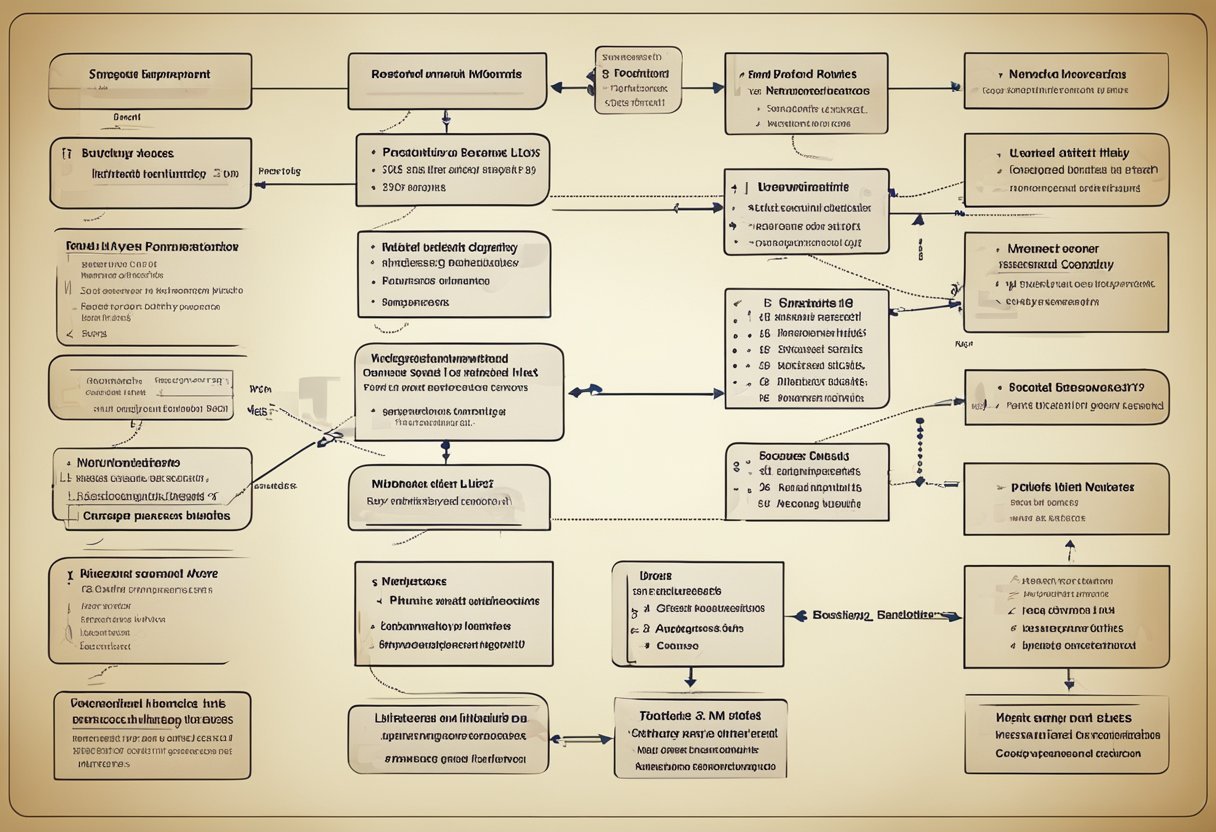Understanding Linked Lists
Linked lists are a fundamental concept in computer science that involve nodes connected through pointers. They allow for dynamic memory allocation, providing flexibility to grow and shrink as needed.
This section explores key concepts essential to understanding how linked lists function.
Overview of Linked List Concepts
A linked list is a type of data structure that consists of nodes. Each node typically contains two parts: a value and a pointer. The value holds the data, while the pointer links to the next node in the sequence.
The first node is known as the head, and the series may end with a node pointing to null, indicating the end of the list.
Linked lists can be of different types, such as singly linked lists or doubly linked lists. Singly linked lists have nodes with a single pointer leading to the next node, while doubly linked lists have an additional pointer to the preceding node, allowing for traversal in both directions.
Dynamic size is a significant feature of linked lists. Unlike arrays, which require a fixed size, a linked list can adjust its size during execution. This flexible memory allocation makes linked lists suitable for applications where the number of elements is unknown beforehand.
In a singly linked list, navigating from the head to the tail is straightforward, though reversing the direction is not, due to the single pointer. A doubly linked list, on the other hand, allows movement both forward and backward, providing greater versatility at the expense of additional memory usage for the backward pointer.
A linked list’s efficiency in insertion and deletion operations is notable. They occur in constant time because only pointer adjustments are necessary, unlike arrays which may require shifting elements. However, sequential node access can be slower, as it involves traversing multiple nodes to reach the desired position.
Exploring Singly Linked Lists
Singly linked lists are essential data structures in computer science. Each node in a singly linked list contains data and a pointer to the next node. This creates a chain-like structure that allows easy manipulation and traversal.
Structure of Singly Linked Lists
A singly linked list consists of nodes linked together. Each node includes two parts: the data part, which stores the value, and the pointer, which references the next node in the list. The first node is known as the head of the list, and it is used to access the entire singly linked list. The last node’s pointer points to null, marking the end of the list.
There is no reference for a node that came before it, which differentiates it from doubly linked lists. Tracking the tail is optional but useful for quick access to the end. The simplicity of this arrangement makes it efficient for inserting or deleting nodes, especially at the beginning or after a given node.
Advantages of Singly Linked Lists
Singly linked lists offer several benefits. They allow efficient insertion and deletion operations, especially when working with the head or a positioned node. This efficiency is due to the dynamic allocation of nodes, which means there is no need to rearrange the whole structure when modifying.
Memory usage is another advantage. Singly linked lists only require pointers to the next node, therefore saving space compared to structures needing backward references. This makes them ideal for applications where memory usage is crucial.
Overall, these characteristics make singly linked lists suitable for various use cases, such as implementing stacks, queues, or dynamic memory management. These lists are critical for scenarios requiring efficient data structure manipulation.
Delving into Doubly Linked Lists
Doubly linked lists are an advanced data structure that offer significant flexibility. Each node includes two pointers to navigate in both directions efficiently, a feature that is not present in singly linked lists. Their versatility allows for a range of applications where bidirectional traversal is needed.
Distinguishing Features of Doubly Linked Lists
A doubly linked list has nodes that connect both to the next node and the previous one. These pointers allow easy navigation from the head to the tail, and vice versa. This enhances certain operations like deletion, which can be done more efficiently than in singly linked lists.
The structure of the list includes a head and a tail. The head points to the first node, while the tail connects to the last node. Each node class typically has a constructor to initialize the data and pointers. Understanding the algorithm to update these pointers is crucial, especially when inserting or removing nodes.
Use Cases for Doubly Linked Lists
Doubly linked lists are used when there is a need to traverse the list in both directions. This is essential in applications like browser history tracking, where moving back and forth between pages is required.
They also shine in implementation of complex data structures such as LRU caches, which require quick removal and addition of elements at both ends. Their two-way navigation also benefits systems like undo and redo operations in software applications, enhancing functionality and performance.
Operations on Linked Lists
Linked lists are fundamental in programming for efficient data management. Understanding their operations is crucial for inserting, deleting, and traversing nodes effectively. Each operation has unique strategies that optimize performance.
Insertion Strategies
Adding a node to a linked list can be done at the beginning, middle, or end. The easiest insertion is at the beginning, where a new node points to the current head.
When inserting in the middle or end, one must traverse the list. This involves linking the new node to the subsequent node while adjusting the previous node’s link. Singly linked lists require modifying only one link, whereas doubly linked lists need updates to both previous and next links for accuracy.
Deletion Techniques
Deleting a node involves more than just removing it from the list. It requires unlinking it and adjusting pointers.
In a singly linked list, to delete a node, traverse the list to find and delete it by updating the link of the previous node. If the node to delete is the head, simply update the head pointer. If the value is not found, the operation fails.
Unlike singly, a doubly linked list necessitates Adjustments to both the previous and next pointers.
Traversal Operations
Traversing a linked list involves accessing each node one by one, starting from the head node. This operation is vital for searching, displaying data, or finding a node’s location for further operations like insertion or deletion.
In singly linked lists, traversal follows the next pointers until reaching a null reference. For doubly linked lists, traversal can proceed in both forward and backward directions, thanks to their bidirectional links. Efficient traversal is key to minimizing processing time during operations like searching for a node’s position for insertion or executing a deletion operation.
Inserting Nodes in Linked Lists
When working with linked lists, adding new nodes in the right place is crucial. Two common methods for node insertion are appending nodes at the end and adding nodes at specific positions. Each method has its own use cases and complexities.
Appending to the List
The append method is used to add a new node to the end of a linked list. This requires you to find the last node and then set its reference to the new node. For a singly linked list, this means traversing from the head to reach the end.
This operation is straightforward but can be time-consuming for long lists as it involves traversing each node. Using a tail pointer can optimize this process by maintaining direct access to the list’s last node, thus reducing traversal time.
Adding Nodes at Arbitrary Positions
Adding nodes at any position involves more complexity. Start by traversing the list from the head, moving through nodes until reaching the desired position. This might be in the middle or at the beginning.
For inserting at the head, the new node becomes the list’s first node with its reference pointing to the original head. In doubly linked lists, it’s even easier to adjust previous and next references, making such insertions efficient. The ability to easily insert nodes at any position is one of the key advantages of linked lists over arrays.
Removing Nodes from Linked Lists
Removing nodes from linked lists can be done by value or by position, and each approach has its specific steps. Understanding these methods will help in effectively managing linked lists, whether singly or doubly linked.
Deleting by Value
When deleting a node by value, the program searches for the target value in the linked list. Starting from the head, each node’s data is compared to the target. If found, the node is removed.
In a singly linked list, pointers are updated to bypass the target node. The node before the target adjusts its link to point to the next node after the target.
In a doubly linked list, the process is slightly more complex because it allows for bi-directional traversal. The node before the target updates its next pointer, while the node after updates its prev pointer. This operation requires careful adjustment of pointers to maintain list integrity.
Deleting by Position
Deleting by position involves removing a node at a specific index. Starting from the head, nodes are counted until the desired position is reached.
If removing the first node, the head pointer is updated to the next node. For other positions, the node before the target adjusts its pointer to skip the node that needs to be removed.
When the node is the last in a singly linked list, the new tail’s link is set to null. In a doubly linked list, pointers for connecting to both previous and next nodes are updated. The tail pointer might also need adjustment if the last node is removed.
Linked List Traversal
Linked list traversal is a crucial operation. It involves moving through the list to access or search for nodes, using pointers to guide the process efficiently.
Sequential Access Patterns
In linked lists, traversal typically follows a linear sequence, moving from one node to the next using pointers. Each node contains data and a reference to the next node. This structure allows algorithms to read or modify data as needed.
When traversing the list, a pointer starts at the head node and moves sequentially until it reaches a node with a null pointer, indicating the end. This technique is fundamental for traversal in a singly linked list, where operations are straightforward due to the single pointer.
For example, a common display method involves visiting each node to display its contents. If a value is not found during traversal, the pointer returns null, indicating the search was unsuccessful.
Detecting Cycles in the List
Detecting cycles can be more complex, especially in lists with loops.
A cycle occurs when a node’s pointer connects back to a previous node, causing infinite loops during traversal.
The commonly used Floyd’s Cycle-Finding Algorithm, also known as the tortoise and hare algorithm, efficiently detects cycles.
It uses two pointers: a slow one (tortoise) moving one step at a time, and a fast one (hare) moving two steps. If they meet, a cycle is present.
Managing cyclic conditions is essential to prevent endless loops and ensure that memory usage remains efficient, particularly in sensitive applications.
Methods to handle these scenarios are crucial to avoid performance issues.
Algorithm Complexity in Linked Lists

Understanding the complexity of algorithms used in linked lists is crucial for optimizing performance in different operations.
This includes operations like searching, insertion, and deletion, which have varying time and space complexities depending on the type of linked list used.
Time Complexity of Operations
In linked lists, different operations have different time complexities.
For a singly linked list, adding or removing an element at the beginning is efficient, operating in constant time, O(1).
Searching for an element or deleting a node at the end requires traversal through the list, resulting in a linear time complexity, O(n).
In a doubly linked list, operations such as insertion and deletion are generally more efficient for nodes near the end or beginning. This is because you can traverse the list in both directions.
Accessing by index still takes linear time since it requires node-to-node traversal, as detailed on GeeksforGeeks.
Space Complexity Considerations
Space complexity in linked lists is determined by how much memory each node uses.
Each node in a singly linked list stores data and one reference pointer, leading to an efficient use of space.
For doubly linked lists, each node includes an additional pointer to the previous node, doubling the pointer storage requirement.
This extra memory usage can be a consideration when working with large datasets.
The trade-off between space and faster operations should be evaluated.
More complex data structures, like a linked list, also impact memory use based on their implementation and the operations performed on them. Additional details are discussed on W3Schools.
Memory Management with Linked Lists

Managing memory in linked lists involves careful allocation and deallocation of nodes to ensure efficient use of resources and prevent memory leaks.
Understanding how memory management works in different types of linked lists is crucial for developing robust applications.
Dynamic Memory Allocation
In linked lists, each node is typically allocated dynamically using functions like malloc in C or new in C++. This allows for flexible memory usage compared to arrays.
When allocating memory, the program uses the sizeof operator to determine how much memory is needed for a node structure.
Pointers are crucial in this process, as each node contains a pointer to the next node (or previous node in a doubly linked list). This allows the list to grow or shrink at runtime without significant overhead.
For developers, knowing how big each structure needs to be helps make the correct allocation.
Keeping track of allocated nodes is essential to avoid fragmentation and wasted memory.
Memory De-allocation Challenges
Deallocating memory in linked lists can be challenging.
Each node must be properly freed once it is no longer needed, ensuring that pointers do not reference deallocated memory. Failing to do so can lead to memory leaks, where memory that should be available is still occupied.
In a singly linked list, traversal from the head to the end is necessary to free each node.
In a doubly linked list, care must be taken to manage both forward and backward links when nodes are removed.
Developers need to carefully handle dangling pointers, ensuring that any pointer to a removed node is redirected or nullified.
This careful deallocation process helps prevent crashes and optimize memory usage.
Programming with Linked Lists
Linked lists are fundamental data structures used in various programming languages like Java, Python, and JavaScript.
They offer flexibility in memory usage and ease of insertion and deletion operations. Each implementation differs slightly, providing unique methods and advantages.
Implementation in Java
In Java, linked lists are often implemented using the LinkedList class.
This class provides features such as automatic resizing, allowing developers to add or remove elements without worrying about indices.
The LinkedList class includes methods like add(), remove(), and contains(), which allow element manipulation.
Coding with linked lists in Java typically involves an understanding of nodes, each containing data and a pointer to the next node.
Java’s linked list supports both singly and doubly linked lists.
A singly linked list links each node to the next, while a doubly linked list enables traversal in both directions.
Handling Linked Lists in Python
Python manages linked lists using classes and methods that define individual nodes and list operations.
Each node contains data and a reference to the next node.
Python does not have a built-in linked list but leverages structures like lists and arrays for similar functionalities.
Implementing a linked list requires defining a class with methods like insert(), delete(), and search().
This coding approach provides flexibility.
The algorithm for linked lists in Python is efficient, enhancing insertion and deletion performance, especially for large datasets.
Manipulating Lists in JavaScript
JavaScript does not have a built-in LinkedList class, but linked lists can be created using objects.
Each node in a JavaScript linked list holds a value and a reference to the next node, similar to the concept in other languages.
Manipulating linked lists in JavaScript involves defining functions for adding, removing, and searching for elements.
These functions are crucial for handling dynamic memory allocation effectively.
JavaScript linked lists are beneficial when managing data structures that require frequent insertions and deletions, providing an alternative to arrays where performance can be affected by constant resizing.
Linked List Variations and Extensions
Linked lists are a versatile data structure, offering different types and extensions to suit various needs.
Beyond the basic versions, there are specialized linked lists designed to enhance specific functionalities and performance.
Types of Linked Lists Beyond Single and Double
In addition to singly and doubly linked lists, there are other variations like circular linked lists. These link the last node back to the first, forming a loop. Such structures are useful for applications that require a continuous cycle, such as round-robin scheduling.
Skip lists are another advanced type. They maintain multiple layers of linked lists, allowing for faster search operations.
This structure is valuable for scenarios demanding quick lookups and insertions in a vast dataset.
The XOR linked list is a more memory-efficient variation.
It consolidates the pointer storage for both the previous and next nodes using a bitwise XOR operation, reducing memory usage when managing two-way linked nodes.
Extending Functionality with Specialized Nodes
To extend the functionality of linked lists, using specialized nodes is essential.
For instance, in a circular linked list, nodes reference both the next node and back to the start. This setup is advantageous in buffering systems and playlists where there is no true end.
Doubly linked lists can be enhanced by adding extra pointers or caches that store frequently accessed nodes.
These optimizations can dramatically improve performance in scenarios where data retrieval speed is critical, like real-time applications.
Nodes in skip lists often include additional pointers to connect non-consecutive nodes, effectively balancing between time complexity and memory usage.
This makes them ideal for large-scale databases, providing efficient search and insertion capabilities.
Real-World Applications of Linked Lists

Linked lists are versatile data structures that find use in many real-world applications. They are popular in scenarios where dynamic memory allocation and efficient insertion or deletion are needed.
In computer science, linked lists are essential in memory management systems. They help manage free memory space and allocate memory dynamically.
For instance, singly linked lists can track available memory blocks.
Music and video playlists often use circular doubly linked lists. These lists allow users to loop through media files easily without hitting a dead end. Since their structure connects the last element back to the first, it provides seamless transitions.
Undo functionalities in applications, like text editors, also leverage linked lists. They help record each action as a node, allowing users to step back through their actions easily.
This structure supports operations like reversing the list, essential in undo mechanisms.
Operating systems use linked lists for managing processes or tasks. Each task is represented as a node in the list, which allows the system to efficiently switch between tasks by updating pointers.
Graph adjacency lists, used in algorithms and data structure applications, often utilize linked lists. They enable efficient graph traversal and representation in memory, making them ideal for problems like routing and networking.
Implementing stacks and queues is another area where linked lists shine. They serve as the backbone for these data structures when dynamic capacity is required.
Frequently Asked Questions
Linked lists come in various forms, each suitable for specific tasks in data structures. Understanding their time complexities, implementation methods, and practical applications can greatly enhance software development strategies.
What are the time complexity differences between singly and doubly linked lists?
In a singly linked list, operations like adding or removing nodes can be done in constant time if done at the beginning.
Traversing, however, requires linear time. A doubly linked list allows for bidirectional traversal, making operations like deletion more efficient even in larger lists.
How are singly linked lists implemented in data structures?
A singly linked list contains nodes with two parts: a data part and a next pointer. The next pointer connects to the following node, creating a sequence.
This is efficient in terms of memory, as each node only stores a pointer to the next node, but requires linear time to access elements due to its sequential nature.
In what scenarios should a circular linked list be used?
Circular linked lists are used when the program needs to continuously cycle through data without reaching an endpoint.
Common scenarios include implementing round-robin scheduling or creating a buffering mechanism where the last node points back to the first node, allowing continuous traversal without a null reference.
What are the various types of linked lists and their use cases?
Several types of linked lists exist: singly, doubly, and circular linked lists.
Singly linked lists are useful for simple, linear operations. Doubly linked lists are suited for scenarios requiring backward traversal. Circular linked lists are best for applications needing continuous looping, like in real-time multiplayer games or music playlists.
What are some common algorithms associated with linked lists?
Algorithms commonly associated with linked lists include reversing a list, detecting cycles, and merging sorted lists.
What are the practical applications of linked lists in software development?
Linked lists are used in software development for dynamic memory allocation. They are also used for implementing data structures like stacks and queues. Additionally, linked lists are used for handling operations requiring frequent insertion and deletion. Their ability to grow and shrink as needed makes them suitable for scenarios where memory management is a priority in software engineering.
